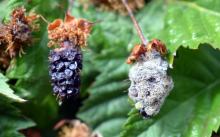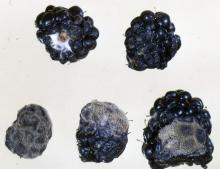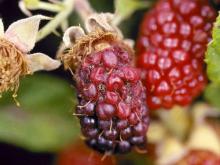Cause A survey in 2015 found the majority of isolates to be Botrytis cinerea, a fungus. This fungus is ubiquitous and attacks many different fruit and ornamental crops. A moist, humid environment is ideal for sporulation and spread of this fungus. Wet weather just before and during bloom is important for disease development. All flower parts are very susceptible. Initial infections of flowers may be latent, such that the fungus is dormant until fruit ripens. Airborne spore concentrations rise and remain elevated during and after harvest.
Fruit rot may be more prevalent in fields under overhead set irrigation systems or where fruit overripens in the field for mechanical harvest. Fruit rot is more common in the 'Evergreen' cultivar. Good air drainage between plants and between rows is important to rapidly dry fruits and foliage after rain or irrigation.
Symptoms Rotted fruit, usually develops a gray fungal growth on the surface. Rotten fruit may mummify and stay attached to the receptacle. The fungus may attack senescent leaves and cause cane infections. Small, black, overwintering structures (sclerotia) may develop on any infected plant part.
Cultural control No single cultural practice provides adequate management of gray mold under highly conducive conditions. Integrate several tactics to manage this disease. The use of cultural tactics reduces reliance on fungicide applications and can help manage fungicide resistance.
- Space plantings to provide good air drainage and drying conditions.
- Adjust irrigation so plants do not stay wet for extended periods of time. Switch from overhead to drip/trickle irrigation.
- Pick fruit at correct stage of maturity; do not allow it to overripen. Reduce the interval between mechanical harvests.
- Pick into shallow containers that will be sold to customers.
- Move harvested fruit to cold storage as soon as possible.
- Spotted-wing drosophila (SWD; Drosophila suzukii) management is recommended although a significant correlation has not been demonstrated between SWD and fruit rots. See the PNW Insect Management Handbook for details.
Chemical control Apply the first spray at 10% bloom, then at regular intervals through bloom. Another spray just before harvest may be needed if rainy weather is expected. Alternate or tank-mix materials from different groups with different modes of action for each application. Limit the use of any one group during the growing season. Strains resistant to many different modes of action have been reported from throughout the world including the Pacific Northwest. Surveys in Oregon from 2014 to 2017 have found Botrytis resistant to fungicide groups 7, 9, and 17.
- Bonide Captan 50 WP at 5 Tbsp/gal water can be used in home gardens - Washington only. Do not use within 3 days of harvest. H
- Captan 80 WDG at 2.5 lb/A. Do not apply within 3 days of harvest. Avoid use when honey bees are active due to larval toxicity. Group M4 fungicide. 48-hr reentry.
- Cueva at 0.5 to 1 gal/100 gal water/A. May be used on day of harvest. Unknown effectiveness in the PNW. Group M1
fungicide. 4-hr reentry. O - Elevate 50 WDG at 1.5 lb/A. Can be used up to and including the day of harvest. Group 17 fungicide. 12-hr reentry.
- Fontelis at 14 to 24 fl oz/A plus another fungicide. Can be used day of harvest. Group 7 fungicide. 12-hr reentry.
- Iprodione-based products can be applied up to and on the day of harvest. Do not mix with insecticides due to honey bee adult and/or larval toxicity. Group 2 fungicides. 24-hr reentry.
- Iprodione 4L AG at 1.5 to 2 pint/A.
- Meteor at 1.5 to 2 pints/A.
- Rovral 4 Flowable at 1.5 to 2 pints/A.
- Kenja 400 SC at 13.5 to 15.5 fl oz/A. Do not use within 7 days of harvest. Group 7 fungicide. 12-hr reentry.
- Luna Tranquility at 16 to 27 fl oz/A. May be used day of harvest. Group 7 + 9 fungicide. 12-hr reentry.
- Oso SC at 6.5 to 13 fl oz/A. May be applied on the day of harvest. Group 19 fungicide. 4-hr reentry. O
- Ph-D WDG at 6.2 oz/A plus an adjuvant. May be applied on the day of harvest. Group 19 fungicide. 4-hr reentry.
- Pristine at 18.5 to 23 oz/A. Do not use with any other tank additive. Can be used day of harvest. Group 7 + 11 fungicide. 12-hr reentry.
- Switch 62.5 WG at 11 to 14 oz/A. May be used up to and including the day of harvest. Group 9 + 12 fungicide. 12-hr reentry.
Note: Tests in western Washington have shown that the product Serenade does not control this disease and is not recommended.
Protexio is registered but is not being sold due to the garlic-like odor it leaves on fruit.
Biological control Many different organisms have been shown to be effective under controlled conditions but control becomes more variable in the field. Combine with cultural tactics and/or integrate with synthetic fungicides for best effectiveness.
- Botector (Aureobasidium pullulans strains DSM 14940 and 14941) at 5 to 10 oz/A depending on water volume. Can be applied day of harvest. Compatible with sulfurs, oils and a few fungicides but not with many synthetic fungicides. 4-hr reentry. O
- BotryStop (Urocladium oudemansii U3 strain) at 2 to 4 lb/A. Keep refrigerated before use. Compatible with many wetting agents, some fungicides and biologicals but not all. Unknown efficacy in the PNW. 4-hr reentry. O
- DoubleNickel 55 (Bacillus amyloliquefaciens strain D747) at 0.25 to 3 lb/A. Unknown efficacy. Group BM02 fungicide. 4-hr reentry. O
- Howler Evo (Pseudomonas chlororaphis strain AFS009) at 20 to 120 oz/A plus a surfactant. Can be used day of harvest. Unknown efficacy. 4-hr reentry. O
- LALStop G46 WG (Clonostachys rosea [formerly Gliocladium catenulatum] strain J1446) at 0.3 to 16 oz/A. Do not use with other products in the tank. 4-hr reentry. O
Reference Grabke, A., Fernández-Ortuño, D., Amiri, A., Li, X., Peres, N.A., Smith, P., and Schnabel, G. 2014. Characterization of iprodione resistance in Botrytis cinerea from strawberry and blackberry. Phytopathology 104:396-402





